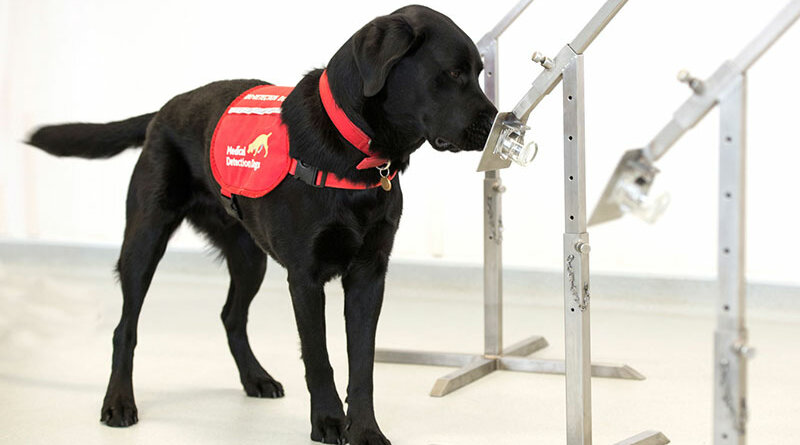Detection Dogs in Training to Sniff Out Covid-19
Human diseases and health conditions—including a variety of cancers, diabetes, UTIs, epilepsy and malaria—have odor signatures. Lucky for us, dogs are experts in identifying them, using their special superpower: their sense of smell. Their latest challenge? Covid-19.
A lot of out-of-the-box thinking has been deployed in the race to find ways to identify and treat those infected with Covid-19. One of the ideas, which builds on what has long been known about the canine sense of smell, was recently announced by a team of researchers from the UK’s London School of Hygiene & Tropical Medicine (LSHTM), Medical Detection Dogs (a registered charity) and Durham University.
Following up on their 2018 proof-of-concept study that identified dogs’ capacity to quickly and accurately sniff out malaria in even asymptomatic individuals, the team suggests that they could be trained to do the same with Covid-19. If so, with six to eight weeks of training, dogs could provide a quick and non-invasive way to identify who needs to be tested. Not only would this help identify carriers when they’re reportedly most contagious, but also, it would put the limited supply of test kits currently available to the most targeted use.
As Claire Guest, co-founder and chief executive of Medical Detection Dogs, said in a late-March interview, “In principle, we’re sure that dogs could detect Covid-19. We are now looking into how we can safely catch the odor of the virus from patients and present it to the dogs. The aim is that dogs will be able to screen anyone … and tell us whether they need to be tested. This would be fast, effective and non-invasive, and make sure limited NHS [National Health Service] testing resources are only used where they are really needed.”
Professor Steve Lindsay of Durham University, the project’s lead investigator, is also thinking about the future. “If the research is successful, we could use Covid-19 detection dogs at airports at the end of the epidemic to rapidly identify people carrying the virus. This would help prevent the re-emergence of the disease after we have brought the present epidemic under control.”
GET THE BARK IN YOUR INBOX!
Sign up for our newsletter and stay in the know.
As far as dogs are concerned, it’s pretty much business as usual. They’re using olfaction, their most highly developed sense, to pick up the scent molecules—volatile organic compounds, or VOCs—that float around a person with each exhalation. It makes no difference to them what those molecules indicate … that the person had a bacon sandwich for lunch or that a potentially deadly cancer is lurking somewhere in their body.
Here’s a quick refresher on canine olfaction. According to Alexandra Horowitz, professor of cognitive science and head of Barnard College’s Dog Cognition Lab, dogs have 300 million olfactory receptors, compared to our trifling 6 million. On top of that, the proportion of their brains devoted to decoding scent is more than 40 times greater than our own. Then, there’s the sniff rate. We sniff once every 1.5 seconds, while dogs sniff 5 to 10 times per second. (And, oh yes—research published in February of this year indicates that, using their noses, dogs have the ability to detect thermal radiation—body heat—which suggests they could also be trained to identify individuals with fevers. Marc Bekoff, a frequent Bark contributor, discusses this work here.)
Here’s another way to visualize canines’ amazing sensory superpower, courtesy of James C. Walker, former director of Florida State University’s Sensory Research Institute: “If you make an analogy to vision, what you and I can see at a third of a mile, a dog could see more than 3,000 miles away, and still see as well.” Or, as another scientist described it, they’re able to detect one rotten apple in a barrel of two million apples.
Obviously, no special training is required for bacon-sandwich detection, but in order to recognize more specialized odors, dogs need to be trained using samples of the target scent. This is where it gets a little trickier; it’s not yet known for sure that Covid-19 has a specific odor. But, as Professor James Logan, head of the department of disease control at LSHTM, said, “We know that other respiratory diseases change our body odor, so there is a chance that it does. And if it does, dogs will be able to detect it.”
Best-case scenario, part one: By this summer in the UK, dogs trained to recognize Covid-19’s unique VOCs could screen up to 250 people per hour, per dog, with a relatively high rate of accuracy. And part two: Around the globe, detection dogs with this specialized training will be making our lives better—as they have for eons—in yet another way: by helping us disrupt and discourage the spread of this debilitating coronavirus.



